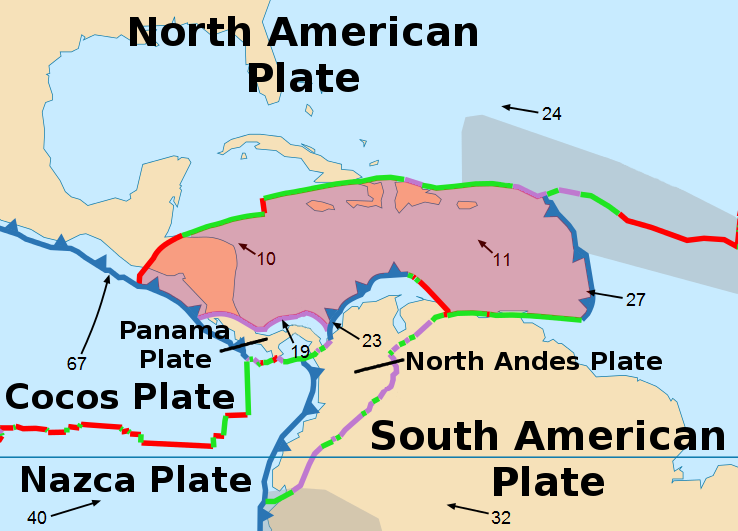Caribbean Plate is surrounded
Caribbean Plate's complex borders
Plates bordering the Caribbean Plate
The Caribbean Plate lies in a complex area. It borders the North American Plate, the South American Plate, the Nazca Plate and the Cocos Plate plus several microplates. These two major plates and two minor plates bordering it includes oceanic and continental crust.
Caribbean Sea covers most of the plate
The Caribbean Sea covers most of the plate with Central America and volcanic islands covering the rest. The edges of the plate have intense seismic activity, frequent earthquakes and volcanic eruptions.

Tectonic plates surrounding Caribbean Plate (purple), NOAA
Lesser ANTILLES active volcanic arc
The Lesser Antilles
The Lesser Antilles volcanic arc lies along the eastern boundary of the Caribbean Plate. The arc of volcanoes is composed of 19 active volcanoes as the South American Plate subducts beneath the Caribbean Plate.
Active volcanoes in the volcanic arc
The active volcanoes in the volcanic arc are stratovolcanoes with steep volcanic cones that formed by lava flows and pyroclastic eruptions. The volcanoes produce lava domes that come in many shapes and sizes. When a lava dome collapses it can produce pyroclastic flows down the side of the volcano destroying everything in its path.
Famous volcanoes
Notable active volcanoes in the Lesser Antilles volcanic arc include Soufriere Hills on Montserrat, Mount Pelee on Martinique and the submarine volcano Kick 'em Jenny near Granada.
trench and plate boundaries
Puerto Rico Trench is deepest part of the Atlantic Ocean
Between the North American Plate and the Caribbean Plate is a transform boundary and a subduction zone. The Puerto Rico trench runs between the two plates and is the deepest part of the Atlantic Ocean. The trench is 8,400 meters deep. Hispaniola, Puerto Rico and the Virgin Islands are on the Caribbean side of the trench.
Caribbean Plate and South American Plate
The southern border of the plate interacts with the South American Plate. The petroleum fields of Venezuela are thought to be a result of the interaction between the two plates.


Click for More Information and to Order
volcanoes and Volcanic Islands
1902 Eruption of Mount Pelee
Mount Pelee on Martinique is a stratovolcano that is part of the Lesser Antilles volcanic arc. The town of St. Pierre was known as the "Paris of the Caribbean." The town was a bustling center of activity that had a harbor and where about 33,000 people lived. The volcano rumbled to life in 1902 and produced the deadliest eruption of the 20th century.
Town of St. Pierre
The volcano is located 7 km away St. Pierre and rose 1,700 meters above the town. The eruption created pyroclastic flows that killed almost everyone in the town. Prior to the eruption geologists did not recognize the dangers of an explosive stratovolcano eruption. The pyroclastic flows swept down the side of the mountain at hurricane speeds destroying everything in its path.
Caribbean Islands
Barbados, Trinidad and Tobago islands all formed on the Caribbean side of the plates. Between these two plates there is a transform fault, thrust faults, and a subduction zone.
Central American Volcanic Arc
The western section of the plate includes Central America. The Cocos Plate in the Pacific Ocean is subducting beneath the Caribbean Plate forming the Central American Volcanic Arc with volcanoes in Guatemala, El Salvador, Nicaragua, and Costa Rica.
KIDS FUN Science Bookstore
Check out Myrna Martin's award winning textbooks, e-books, videos and rock sets. The Kids Fun Science Bookstore covers a wide range of earth science topics. Click here to browse.










